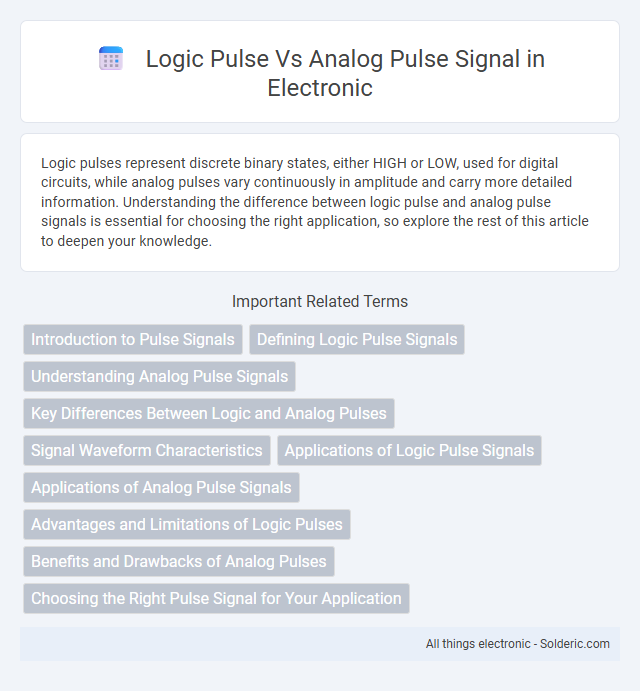Logic pulses represent discrete binary states, either HIGH or LOW, used for digital circuits, while analog pulses vary continuously in amplitude and carry more detailed information. Understanding the difference between logic pulse and analog pulse signals is essential for choosing the right application, so explore the rest of this article to deepen your knowledge.
Comparison Table
| Feature | Logic Pulse Signal | Analog Pulse Signal |
|---|---|---|
| Signal Type | Digital (Binary) | Continuous |
| Amplitude | Fixed (High or Low) | Variable |
| Information Encoding | Discrete logic levels (0 and 1) | Amplitude and duration variations |
| Noise Immunity | High | Lower |
| Typical Applications | Digital circuits, microcontrollers | Sensors, communication systems |
| Frequency Range | Wide, depends on circuit design | Depends on signal source |
| Signal Processing | Easier with digital components | Requires analog components |
| Power Consumption | Generally lower | Can be higher |
Introduction to Pulse Signals
Pulse signals are fundamental in electronics, representing rapid changes in voltage or current used to transmit information. Logic pulse signals consist of discrete voltage levels, typically corresponding to binary states 0 and 1, enabling digital system communication. Analog pulse signals vary continuously in amplitude or duration, encoding information through gradual changes, common in modulation and sensor data transmission.
Defining Logic Pulse Signals
Logic pulse signals represent discrete, binary voltage levels corresponding to digital states, typically defined as either a high (1) or low (0) voltage. These pulses exhibit rapid transitions between fixed voltage thresholds, enabling clear differentiation and reliable interpretation in digital circuits. Unlike analog pulse signals, logic pulses lack intermediate values, ensuring precise timing and signal integrity for digital processing systems.
Understanding Analog Pulse Signals
Analog pulse signals vary continuously in amplitude, frequency, or duration, representing information through changes in voltage levels over time. Unlike logic pulse signals, which switch abruptly between discrete states (typically 0 and 1), analog pulses provide richer data due to their infinite range of values. Understanding analog pulse signals allows you to interpret more complex information in systems like audio processing, sensor outputs, and communication devices.
Key Differences Between Logic and Analog Pulses
Logic pulses represent digital signals with discrete voltage levels, typically defined as binary states (0 and 1), while analog pulses vary continuously in amplitude, encoding information through voltage changes over time. The key differences between logic and analog pulses lie in their signal representation--logic pulses are ideal for digital systems requiring clear, noise-immune switching states, whereas analog pulses are used in systems needing precise amplitude variations for accurate information transmission. Your choice between logic and analog pulses depends on whether your application demands distinct digital control signals or nuanced analog data.
Signal Waveform Characteristics
Logic pulse signals consist of discrete voltage levels representing binary states, typically switching abruptly between high and low levels, resulting in square or rectangular waveforms with sharp rise and fall times. Analog pulse signals vary continuously within a range, producing smooth, often sinusoidal or trapezoidal waveforms with gradual transitions reflecting signal amplitude variations. Your application's choice depends on whether precise digital state representation or nuanced analog information is required for accurate signal processing.
Applications of Logic Pulse Signals
Logic pulse signals are widely used in digital electronics, communication systems, and computer interfaces to represent binary information with precise timing and sharp transitions. These signals enable reliable synchronization in clock circuits, pulse width modulation for motor control, and digital data transmission in microprocessors and programmable logic devices. High noise immunity and easy interfacing with digital components make logic pulse signals essential for automation, signal processing, and embedded system applications.
Applications of Analog Pulse Signals
Analog pulse signals are widely used in biomedical instrumentation, such as electrocardiograms (ECG) and pulse oximeters, where accurate representation of varying biological signals is essential. In industrial automation, these signals control machinery by conveying precise information about temperature, pressure, or flow rates. Your ability to interpret analog pulses allows for enhanced monitoring and control in complex systems requiring continuous and variable data input.
Advantages and Limitations of Logic Pulses
Logic pulses offer precise digital representation, enabling efficient noise immunity and reliable data transmission in digital circuits. Their key advantage lies in clear binary states that simplify processing, while limitations include susceptibility to timing issues and reduced ability to convey amplitude variations compared to analog pulses. These constraints make logic pulses ideal for digital communication but less suitable for applications requiring detailed signal modulation.
Benefits and Drawbacks of Analog Pulses
Analog pulses offer the benefit of conveying detailed information through continuous voltage variations, enabling finer signal interpretation compared to binary logic pulses. Their sensitivity to amplitude and duration variations allows for nuanced control in applications such as audio processing and instrumentation. However, analog pulses are more susceptible to noise and signal degradation over distance, which can reduce accuracy and reliability in transmission.
Choosing the Right Pulse Signal for Your Application
Choosing the right pulse signal depends on the specific application requirements and system compatibility. Logic pulses, characterized by discrete voltage levels representing binary states, are ideal for digital circuits and microcontroller interfacing due to their noise immunity and easy processing. Analog pulses vary continuously in amplitude, making them suitable for applications requiring signal modulation, precise timing variations, or pulse shape analysis in sensor and communication systems.
logic pulse vs analog pulse signal Infographic

 solderic.com
solderic.com